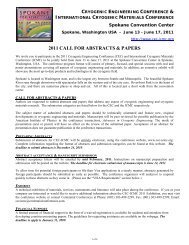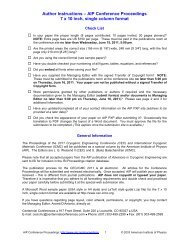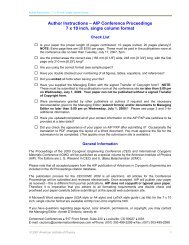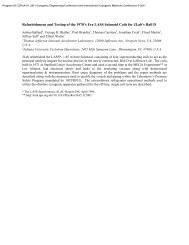CEC Abstracts in PDF format (as of 7/3/07) - CEC-ICMC 2013
CEC Abstracts in PDF format (as of 7/3/07) - CEC-ICMC 2013
CEC Abstracts in PDF format (as of 7/3/07) - CEC-ICMC 2013
Create successful ePaper yourself
Turn your PDF publications into a flip-book with our unique Google optimized e-Paper software.
<strong>CEC</strong> 20<strong>07</strong> - <strong>Abstracts</strong><br />
C1-F-02 Cryogenic Thermal Performance Test<strong>in</strong>g <strong>of</strong><br />
Bulk-Fill and Aerogel Insulation Materials<br />
B.E. Scholtens, J.E. Fesmire, J.P. S<strong>as</strong>s, NASA KSC;<br />
S.D. Augustynowicz, K.W. Heckle, Sierra Lobo, Inc.<br />
The research test<strong>in</strong>g and demonstration <strong>of</strong> new bulk-fill materials for<br />
cryogenic thermal <strong>in</strong>sulation systems w<strong>as</strong> performed by the<br />
Cryogenics Test Laboratory at NASA Kennedy Space Center.<br />
Thermal conductivity test<strong>in</strong>g under actual-use cryogenic conditions is<br />
a key to understand<strong>in</strong>g the total system performance encomp<strong>as</strong>s<strong>in</strong>g<br />
eng<strong>in</strong>eer<strong>in</strong>g, economics, and materials factors. A number <strong>of</strong> bulk fill<br />
<strong>in</strong>sulation materials, <strong>in</strong>clud<strong>in</strong>g aerogel beads, gl<strong>as</strong>s bubbles, and<br />
perlite powder, were tested us<strong>in</strong>g a new cyl<strong>in</strong>drical cryostat. Boundary<br />
temperatures for the liquid nitrogen boil-<strong>of</strong>f method were typically<br />
293 K and 77 K. Tests were performed <strong>as</strong> a function <strong>of</strong> vacuum<br />
pressure level from high vacuum to no vacuum conditions. Results<br />
are compared with other complementary test methods <strong>in</strong> the range <strong>of</strong><br />
300 K to 10 K. Various test<strong>in</strong>g techniques are shown to be required to<br />
obta<strong>in</strong> a complete understand<strong>in</strong>g <strong>of</strong> the operat<strong>in</strong>g performance <strong>of</strong> a<br />
material and to establish a b<strong>as</strong>is for answers to design eng<strong>in</strong>eer<strong>in</strong>g<br />
questions.<br />
C1-F-03 Multilauer Insulation for Atl<strong>as</strong><br />
S. Kozub, K. Polkovnikov, A. Hartchenko, Institute for<br />
High Energy Physics.<br />
Multilayer <strong>in</strong>sulation consists <strong>of</strong> alum<strong>in</strong>ized mylar and mylar cloth<br />
spacer for ATLAS (LHC) w<strong>as</strong> manufactured and tested at Institute for<br />
High Energy Physics (Protv<strong>in</strong>o, Russia). The paper presents<br />
description <strong>of</strong> facility for the multilayer <strong>in</strong>sulation test <strong>as</strong> well <strong>as</strong><br />
results <strong>of</strong> g<strong>as</strong>s<strong>in</strong>g <strong>in</strong> vacuum rate and heat leakage me<strong>as</strong>urements for<br />
the <strong>in</strong>sulation.<br />
C1-F-04 Test<strong>in</strong>g <strong>of</strong> a Vacuum Insulated Flexible L<strong>in</strong>e<br />
With Flow<strong>in</strong>g Liquid Nitrogen Dur<strong>in</strong>g the Loss <strong>of</strong><br />
Insulat<strong>in</strong>g Vacuum<br />
J.A. Demko, M.J. Gouge, R.C. Duckworth, Oak<br />
Ridge National Laboratory; M. Roden, Southwire<br />
Co..<br />
Long length vacuum <strong>in</strong>sulated l<strong>in</strong>es are used to carry flow<strong>in</strong>g liquid<br />
nitrogen <strong>in</strong> several high temperature superconduct<strong>in</strong>g cable projects.<br />
An important, but rare, failure scenario is the abrupt or cat<strong>as</strong>trophic<br />
loss <strong>of</strong> the thermal <strong>in</strong>sulat<strong>in</strong>g vacuum produc<strong>in</strong>g a rapid <strong>in</strong>cre<strong>as</strong>e <strong>in</strong><br />
heat transfer to the liquid nitrogen stream. In this <strong>in</strong>vestigation, a<br />
vacuum super<strong>in</strong>sulated 3 <strong>in</strong>ch by 5 <strong>in</strong>ch NPS is subjected to an abrupt<br />
loss <strong>of</strong> vacuum <strong>in</strong> order to me<strong>as</strong>ure the response <strong>of</strong> a flow<strong>in</strong>g liquid<br />
nitrogen stream and the temperature response <strong>of</strong> the cryostat. The<br />
me<strong>as</strong>ured outlet stream temperature h<strong>as</strong> a slight peak shortly after the<br />
loss <strong>of</strong> vacuum <strong>in</strong>cident and drops to a steady state value. The heat<br />
loads me<strong>as</strong>ured before and after the vacuum loss event are reported.<br />
Some me<strong>as</strong>urements <strong>of</strong> the temperatures <strong>in</strong> the multi-layer<br />
super<strong>in</strong>sulation are also discussed.<br />
Research sponsored by the U.S. Department <strong>of</strong> Energy - Office <strong>of</strong><br />
Electricity Delivery and Energy Reliability, Superconductivity<br />
Program for Electric Power Systems under contract DE-AC05-<br />
00OR22725 with Oak Ridge National Laboratory, managed and<br />
operated by UT-Battelle, LLC.<br />
C1-F-05 Radiation heat me<strong>as</strong>urement on thermally<br />
isolated double-pipe for DC superconduct<strong>in</strong>g power<br />
transmission<br />
M. Hamabe, S. Yamaguchi, Chubu University; A.<br />
N<strong>in</strong>omiya, Seikei University; Y. Ishiguro, S. Kusaka,<br />
JFE Steel Corporation.<br />
Multilayer <strong>in</strong>sulation (MLI) is a strong tool to reduce the radiation<br />
heat and is widely used for the cryogenic systems. However, the use<br />
<strong>of</strong> the MLI leads to a huge <strong>in</strong>cre<strong>as</strong>e <strong>of</strong> the surface area <strong>in</strong> vacuum; it<br />
takes extremely long time to reach a satisfactory vacuum for the<br />
thermal isolation, or the nitrogen g<strong>as</strong> flush<strong>in</strong>g is needed several times.<br />
We have started the experiment by us<strong>in</strong>g the test bench <strong>of</strong> the DC<br />
superconduct<strong>in</strong>g (DC-SC) power cable <strong>in</strong> Chubu University. S<strong>in</strong>ce the<br />
DC-SC power cable is free from the AC losses, the acceptable<br />
radiation heat can be higher for this cable than the AC-SC power<br />
cable. Therefore, we are study<strong>in</strong>g the possibility <strong>of</strong> the radiation shield<br />
without the MLI. The vacuum pump<strong>in</strong>g process and the radiation heat<br />
are me<strong>as</strong>ured for the thermally isolated double-pipes (<strong>of</strong> the same size<br />
<strong>as</strong> those for the DC-SC PT cable) with the various surfaces. While the<br />
radiation heat for the liquid-nitrogen-filled double-pipe with the MLI<br />
radiation shield w<strong>as</strong> 1/100 <strong>of</strong> that with the bare sta<strong>in</strong>less steel surface,<br />
the reachable vacuum pressure with the MLI w<strong>as</strong> 10 times poorer than<br />
that with the bare surface. We will also discuss a novel and<br />
convenient radiation shield<strong>in</strong>g method for the different surface<br />
processes <strong>in</strong> this work.<br />
C1-F-06 Low temperature heat transfer properties <strong>of</strong><br />
electrical <strong>in</strong>sulation for the Next European Dipole<br />
J. Pol<strong>in</strong>ski, B. Baudouy, CEA Saclay; S. Canfer, G.<br />
Ellwood, RAL.<br />
The heat transfer properties <strong>of</strong> the electrical multilayer <strong>in</strong>sulations <strong>of</strong><br />
the Next European dipole h<strong>as</strong> been tested under various conditions at<br />
low temperature. The electrical <strong>in</strong>sulation is made <strong>of</strong> E-gl<strong>as</strong>s fibre<br />
with a pla<strong>in</strong> weave and RAL epoxy system 227 (DGEBF epoxy res<strong>in</strong><br />
and DETD aromatic hardener). The samples have been tested <strong>in</strong><br />
superfluid helium where heat is applied perpendicularly to the fibres<br />
between 1.6 K to 2.1 K and their thermal conductivity, longitud<strong>in</strong>al to<br />
the fibres, had been also me<strong>as</strong>ured at low temperature below 77 K.<br />
This work w<strong>as</strong> supported <strong>in</strong> part by the European Community–<br />
Research Infr<strong>as</strong>tructure Activity under the FP6 “Structur<strong>in</strong>g the<br />
European Research Area” program (CARE, contract number RII3-<br />
CT-2003-506395).<br />
C1-F-<strong>07</strong> Flexible Aerogel Composites for Cryogenic<br />
Insulation<br />
R. Trifu, R. Begag, G. Gould, O. Evans, S. White,<br />
Aspen Aerogels, Inc..<br />
Low-density, flexible aerogel composites <strong>of</strong>fer a variety <strong>of</strong><br />
performance advantages over other <strong>in</strong>sulation materials for cryogenic<br />
<strong>in</strong>sulation applications, particularly Multi-Layer Insulation (MLI).<br />
These advantages <strong>in</strong>clude reduced weight, <strong>in</strong>cre<strong>as</strong>ed durability, lower<br />
total costs, and dramatic improvements <strong>in</strong> lead-times required for<br />
fabrication / <strong>in</strong>stallation <strong>of</strong> the <strong>in</strong>sulation with equal thermal<br />
performance. Additionally, large error bars <strong>of</strong>ten <strong>as</strong>sociated with the<br />
thermal model<strong>in</strong>g <strong>of</strong> MLI can be elim<strong>in</strong>ated with the use <strong>of</strong> aerogel<br />
composites. These low density aerogel composites have been found<br />
to be compatible with sensitive space sensors. Outg<strong>as</strong>s<strong>in</strong>g data along<br />
with encapsulation concepts for the aerogel composites will be<br />
discussed. A ‘higher’ density aerogel composite for <strong>in</strong>sulat<strong>in</strong>g liquid<br />
oxygen transfer l<strong>in</strong>es and storage conta<strong>in</strong>ers will also be presented.<br />
Page 6 <strong>of</strong> 53






